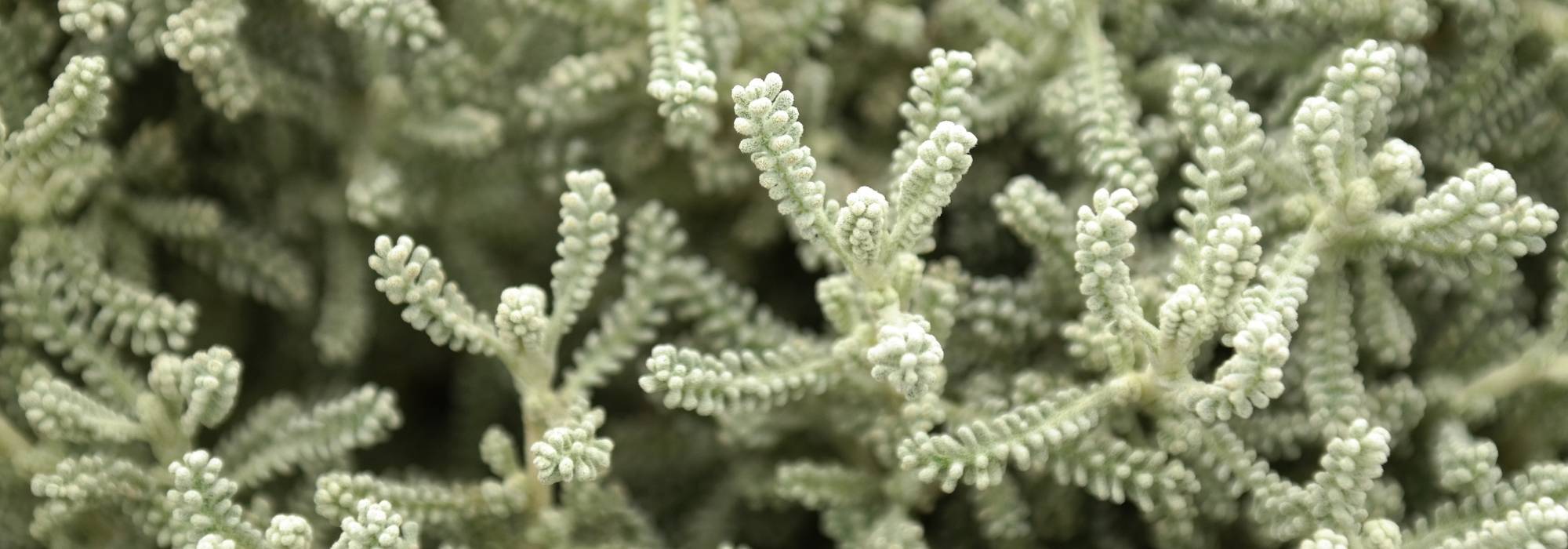
Santolina, Lavender cotton: planting, pruning and care
Contents
Santolina in a nutshell
- Santolina, like lavender, with its fine aromatic evergreen grey or green foliage, will brighten the garden even in winter
- An essential perennial shrub for dry gardens, with summer flowering in bright yellow pompoms or cream-white
- It forms a dense, bright cushion and is easy to care for
- Hardy and undemanding, perfectly adapted to drought, it grows in full sun in very free-draining, poor, stony soil
- An emblematic plant of rockeries, dry slopes, low hedges and gravel gardens
Message from our expert
Like lavender, Santolina or santolina immediately evokes garrigue and southern sunshine from which it originates. Although not used in cooking, santolina is an essential perennial shrub for dry gardens.
From grey santolina (Santolina chamaecyparissus) or ‘little cypress’, to the green santolina with rosemary leaves, this small typically southern bush is prized for its evergreen, aromatic foliage, topped by summer flowering in yellow or cream pom-poms in the white santolina (Santolina pinnata subsp neapolitana ‘Edward Bowles’).
Rather hardy for a Mediterranean plant, santolina fears neither drought, sea spray nor unforgiving soils; it likes arid ground and well-drained, poor, rather calcareous soils. In rockeries, as edging, in low hedges or in pots, add it to your garden!
Its dried flowers will perfume your linen cupboards and serve as a moth repellent!
How to prune santolina, how to pair it successfully in a contemporary garden or sun-loving naturalistic garden, discover tips from our gardening experts and our collection of santolinas.
And get inspired by our pairing ideas with our Mediterranean perennials and plants for dry gardens.
Description and botany
Botanical data
- Latin name Santolina
- Family Asteraceae
- Common name Santoline, lavender cotton
- Flowering June to September
- Height 0.30 to 0.75 m
- Sun exposure sun
- Soil type any well-drained soil
- Hardiness -15°C
Small bush or shrub of the large Asteraceae family, Santolina or santolina grows on rocky slopes and arid hillsides of Mediterranean regions. This garrigue plant has long been cultivated in gardens of southern France. The genus, more varied than it seems, includes 18 species divided between grey santolinas and green santolinas. The best known and hardiest is the silver santolina, Santolina chamaecyparissus, also known as Santolina ‘little cypress’. Horticultural hybrids also exist, such as Santolina ‘Lemon Fizz’ with its attractive zesty green foliage.
This woody perennial forms a compact rounded bush with a short, dry trunk, reaching 30 to 75 cm in height and sometimes 1 m in spread, depending on growing conditions. Stems are most often woody and prostrate, though some santolinas produce erect stems (Santolina serratifolia). Lateral shoots root very easily, spreading into neat clumps. Growth is rapid and individual plants age relatively quickly.
Plant forms a dense cushion with fine foliage made up of entire or very dentate leaves, narrow-oblong, pinnatisect or pinnate and arranged alternately on highly ramified branches. Leaf shape varies between species. From base to tip they may consist, in Santolina chamaecyparissus, of 4 rows of small cylindrical lobes edged with very fine teeth reminiscent of cypress scales, hence the nickname “little cypress”, or appear as long feathery laces in Santolina pinnata. Flexible and glossy, they resemble rosemary leaves in Santolina rosmarinifolia.
Leaves measure 2 to 8 cm long and are covered with a thick white felt or tomentum in grey (tomentose) santolinas.
Although this evergreen foliage is most often remarkable for shades of grey, grey-green or grey-white, some santolinas display bright lime-green foliage as in cultivar ‘Lemon Fizz’, or a deep green in Santolina rosmarinifolia.

Some santolinas: Santolina chamaecyparissus, Santolina ‘Edward Bowles’ and Santolina ‘Lemon Fizz’ with superb golden foliage
Highly aromatic when crushed, foliage gives off a pungent scent reminiscent of bergamot, olive oil and turpentine. In a warm sunny situation, the whole plant emits a powerful aroma that is simultaneously peppery, camphorous and sweetish.
From this rounded bush emerge long, fine stems, pubescent or glabrous, each bearing at its tip small globular inflorescences. From June to September, small solitary heads 0.5 to 2 cm in diameter open. These little domed pompons, lacking ligules and surrounded by long bracts, are formed of tightly packed florets resembling small golden-yellow buttons (Santolina chamaecyparissus, S. serratifolia) or creamy white (‘Edward Bowles‘).
This melliferous flowering, remarkably abundant, renews throughout summer, attracting many pollinating insects, particularly bees.
These pretty pompons make long-lasting dried bouquets.
Santolina is a Mediterranean plant that nonetheless tolerates cold fairly well down to around -15°C, and grows across France. Essential in coastal and Mediterranean gardens. In cold, wet regions it may start to suffer from about -10°C and is better grown in a pot.
Naturally occurring on arid slopes, Santolina is a dry-garden plant par excellence! It grows in full sun, in any poor, preferably calcareous soil, even stony or rocky, provided it is very well drained.
Versatile, Santolina integrates perfectly into all gardens and especially into a scree garden. It is equally at ease in rockery, as silver or golden punctuation within a border, in a formal edging, as a low hedge, tumbling down a dry bank, or in a pretty pot or trough on a terrace.
Also makes a very good groundcover.
Like lavender, santolina has many medicinal virtues. Santolina essential oil is known for vermifuge and antispasmodic properties. Dried flowers are used in infusions and, placed in small sachets, will perfume wardrobes and keep moths away.
Main species and varieties
From Santolina neapolitana ‘Edward Bowles’ with pale yellow flowers, to the bright ‘Lemon Fizz’ with acid-green foliage, choice of santolinas is more extensive than it appears.
Most widespread and hardiest is the silver santolina, Santolina chamaecyparissus or ‘little cypress’. Santolina serratifolia, a very pretty botanical santolina with upright stems, Santolina pinnata ssp. neapolinata, syn. S. tomentosa, a species often represented by cultivar ‘Edward Bowles’ with feathery foliage, and santolina rosmarinifolia (syn S. virens, S. viridis) with bright yellow flowers and fine, glossy foliage similar to that of rosemary, are also frequently found in cultivation.
Most popular
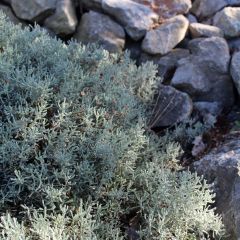
Santolina chamaecyparissus
- Flowering time July to September
- Height at maturity 40 cm
Our favourites
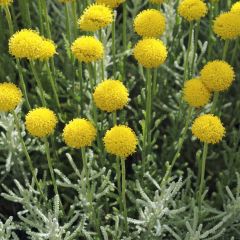
Santolina serratifolia
- Flowering time July to September
- Height at maturity 40 cm
Discover other Santoline - Lavender Cotton
View all →Available in 2 sizes
Available in 2 sizes
Available in 0 sizes
Available in 2 sizes
Available in 1 sizes
Available in 1 sizes
Available in 1 sizes
Planting
Where to plant Santolina?
Santolina is the Mediterranean plant par excellence! This undershrub of rockery is perfectly equipped against drought and long hot summers. It also copes very well with sea spray in coastal gardens. From its origins it has retained a taste for arid, very free-draining, poor and stony soils in which it ages better. It will adapt to any ordinary soil as long as it does not retain water.
It requires a very free-draining soil because it fears heavy soils, especially in winter: soil saturated with water in summer as well as winter will be fatal. With reasonable hardiness down to -12/-15°C in drained soil, it is advisable to grow it in a raised bed, sheltered by a south-facing wall, and in a pot to overwinter in the coldest and wettest regions.
It loves heat and full sun, which will enhance the colour of its foliage and intensify its pungent scent.
Santolina is a boon for dry ground where it forms all year round pretty golden or silvery clumps in large or small, highly graphic borders, in ribbons in very regular low hedges, in rockeries and dry banks or to act as groundcover in the most inhospitable areas of the garden.
It is also useful to fill gaps in a border.
Santolina can also be grown in a pot on the terrace or balcony, to overwinter frost-free in the wettest regions.
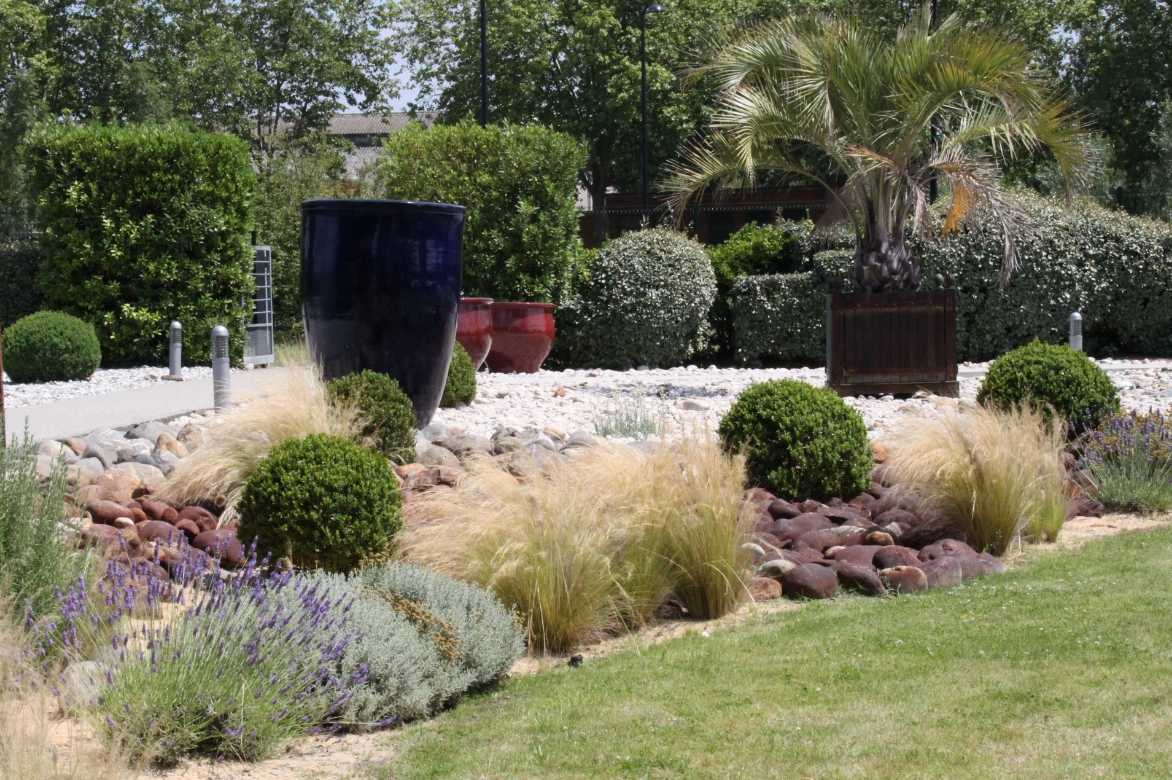
Santolina surrounded by stipa, lavender and box balls
When to plant Santolina?
Santolina is planted in spring in March–April after frosts when temperatures have sufficiently eased, or in autumn from September to October in warm climates.
How to plant Santolina?
In open ground
In heavy or clay soil, incorporate grit or coarse sand into the bottom of the planting hole. If ground is too wet, plant on a slope or in a raised rockery. Space plants 30 to 50 cm apart, 20 to 30 cm for forming a hedge. Due to its vigorous growth, 1 plant per m2 is enough.
- Dig a hole 3 to 4 times wider than the rootball
- Work the excavated soil well to loosen it and enrich it with coarse sand or grit
- Spread a layer of gravel at the bottom of the hole
- Place the Santolina in bucket in the centre of the planting hole, burying the collar well
- Backfill then firm down lightly
- Water well at planting then moderately without flooding the roots
Succeed in planting your santolinas by following our advice in our video “How to plant a bush”
To grow Santolina in a pot
Santolina adapts very well to pot culture; there are even small compact varieties such as Santolina chamaecyparissus ‘Nana’, perfect for this use.
Substrate must be very free-draining to avoid stagnant moisture and root rot. Improve drainage with gravel, coarse sand, or stones.
- In a large container at least 50 cm in diameter, spread a good drainage layer (grit or clay pebbles)
- Plant your Santolina in a mix of garden soil or potting compost for Mediterranean plants and coarse river sand or pumice
- Water at planting then sparingly
- In cold regions, overwinter the pot indoors and bring it back out in spring
⇒ Discover everything you need to know: How to grow Santolina in a pot?
Care and maintenance
Santolina is an undemanding plant that requires very little. What’s more, it’s a robust, rarely diseased plant so long as soil remains well drained: in overly wet soil it is susceptible to fungal diseases. Apart from regular pruning, it needs very little attention.
It is unfazed by sun and copes without problem with long, arid summers characteristic of Mediterranean climate, requiring no watering once well rooted. Water during first summer after planting then only in case of prolonged drought and always sparingly.
In a pot, water more frequently, always allowing substrate to dry out well between waterings.
No fertiliser is needed for this spartan plant; in fact it is discouraged — soil that is too rich encourages its decline!
In regions north of the Loire, wrap aerial parts with a winter fleece and bring potted santolinas indoors before first frosts. Keep substrate almost dry during winter.
And follow our advice to care for perennials and protect plants from cold and frost
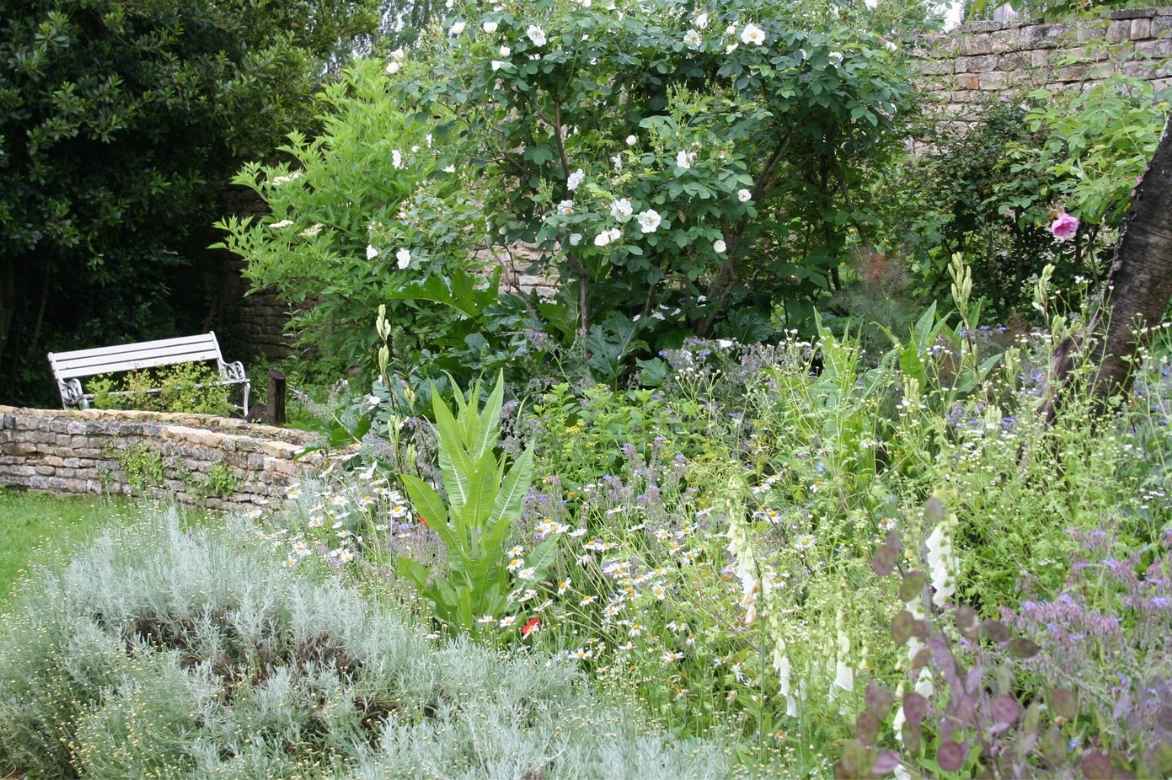
Santolinas along a border
When and how to prune Santolina?
Pruning Santolina is essential to keep a neat compact, rounded habit. It tolerates regular pruning well in late winter and in summer, which prevents it from forming old wood.
- Each year, in March, shear the largest young shoots back by two-thirds of their length, depending on the size of the plant
- Rejuvenate older plants by cutting them back to ground level each year in late winter
- During the season, in May or in summer, shorten the clump with a pruning shear to even it up
- After flowering, simply cut back spent stems with a pruning shear as the plant tends to become misshapen: hang them upside down to dry for making dried bouquets
⇒ Find all our tips: How to prune Santolina?
Multiplication
Santolina multiplies easily by semi-ripe cuttings in July–August. Sowing in spring or autumn with seeds from previous year is possible but often more delicate.
Taking cuttings of Santolina
- Take lignified shoots without flower but with a heel of about 10 cm
- Remove leaves from lower half of stem
- Insert cuttings into seed tray or into buckets in a well-draining mix of river sand and turf
- Keep substrate moist until rooting
- Protect young plants from frost under cold frame
- Plant out following spring
- Pinch out tops of young plants to encourage bushy growth
- Water well during first year after planting
⇒ Discover our tutorial : How to take a cutting from Santolina?
Combining santolina with other plants in the garden
Mediterranean plant by nature, Santolina is essential in dry gardens and wild, sun‑baked areas, in a scree garden or rockery alongside drought‑resistant perennials and Mediterranean perennials evoking garrigue, such as creeping rosemary, thymes and sages, cistus, helianthemums, artemisias and sedums.
It also finds its place in all contemporary gardens near large Agaves with a few small grasses such as Stipa pennata or Stipa tenuifolia, and in sunny naturalistic gardens with Californian poppies, hollyhocks and dry‑ground euphorbias.
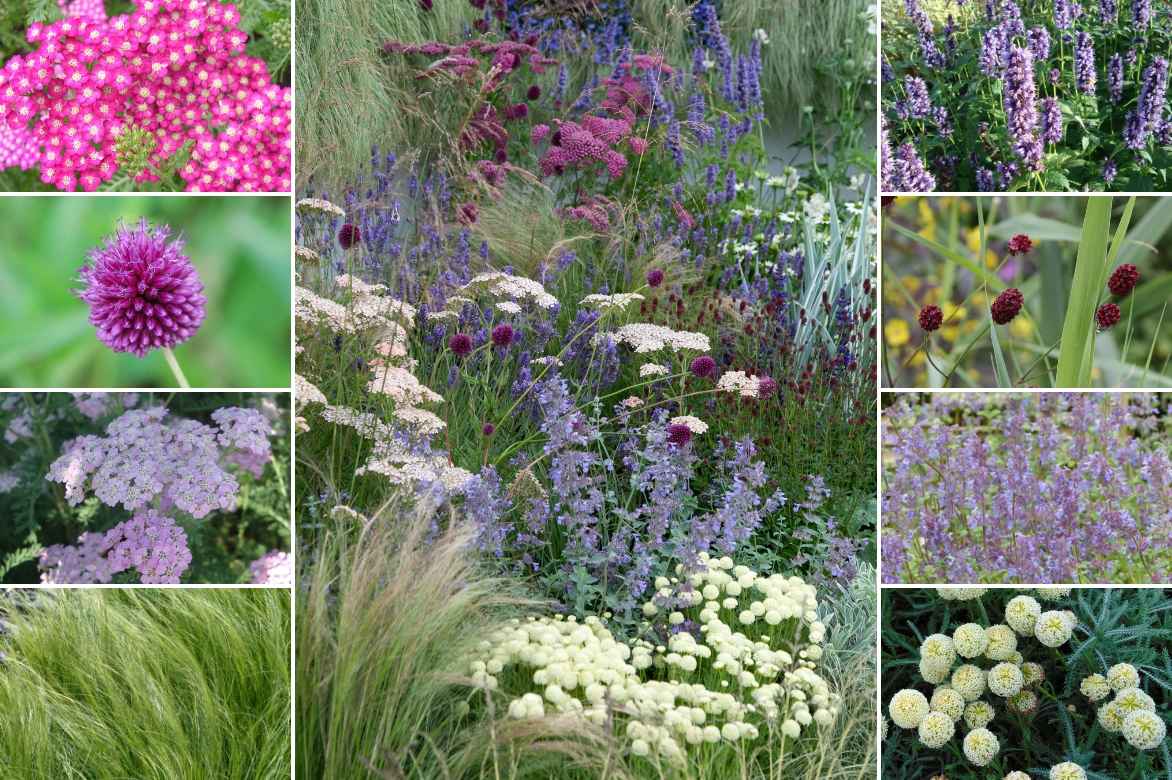
An example of a natural planting : left column –> Achillea millefolium ‘Cerise Queen’, Allium sphaerocephalon, Achillea millefollium ‘Wonderfull Wampee’, Stipa tenuifolia / right column –> Agastache ‘Black Adder’, Sanguisorba officinalis ‘Chocolate Tip’, Nepeta faassenii ‘Siw Hills Giant’ and Santolina ‘Edward Bowles’
Natural companion to lavender, it is also a good plant to cover base of Mediterranean bushes such as oleanders, creeping broom or of climbing roses or buddleia, paired with mignonette carnations.
On an arid slope, plant it with a Delosperma at the foot of small dry‑soil bushes (Hertia cheirifolia, Hypericum olympicum), or beneath an olive.
Its attractive silvery foliage pairs easily with complementary colours such as yellow of coreopsis, some heleniums and Iris germanica, a small potentilla, while its flowers provide a lovely contrast with blue flowers of caryopteris, ceanothus, aubrieta or Perovskia.
It will form a display of beautiful, woolly grey foliage when paired with an Artemisia or with Helichrysum italicum.
Useful resources
- A small selection of drought-resistant perennials, ideal for gardens without irrigation!
- What to plant in stony soil?
- Which plants for a sunny naturalistic garden?
- Discover Elizabeth’s Mediterranean garden!
Frequently asked questions
-
Do santolinas need pruning?
Yes, pruning is recommended because it helps keep santolina's habit dense and rounded and, above all, it will be less likely to produce old wood. Moreover, this plant does not mind regular pruning.
- Subscribe!
- Contents
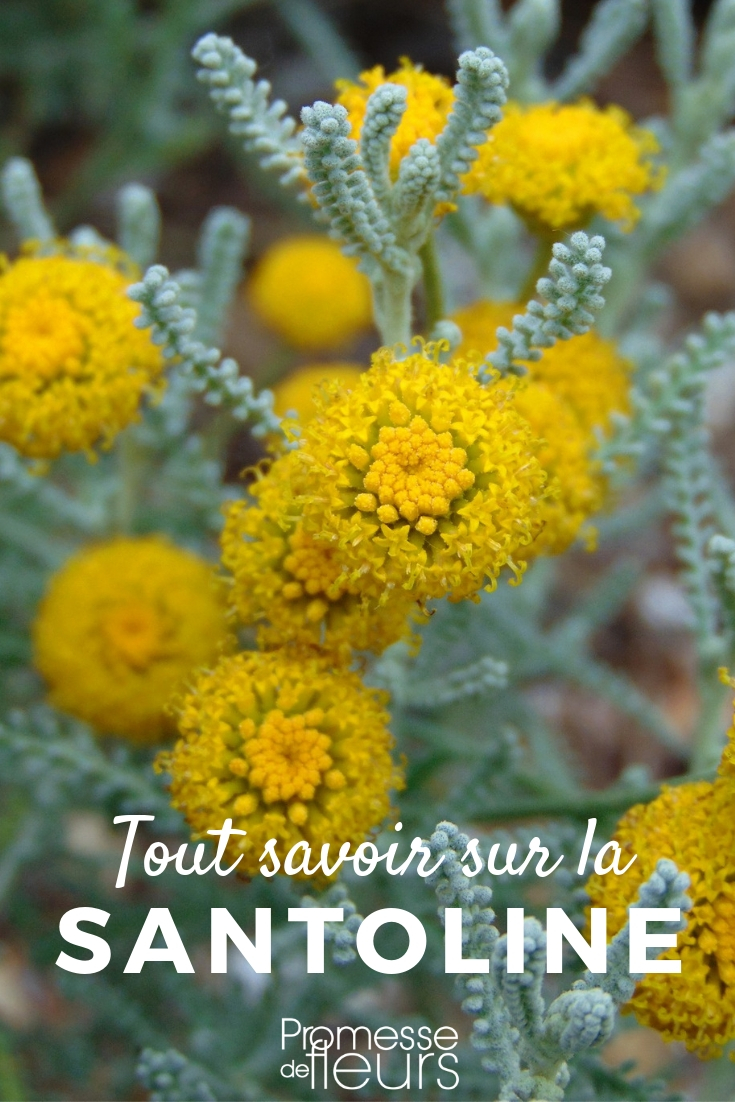































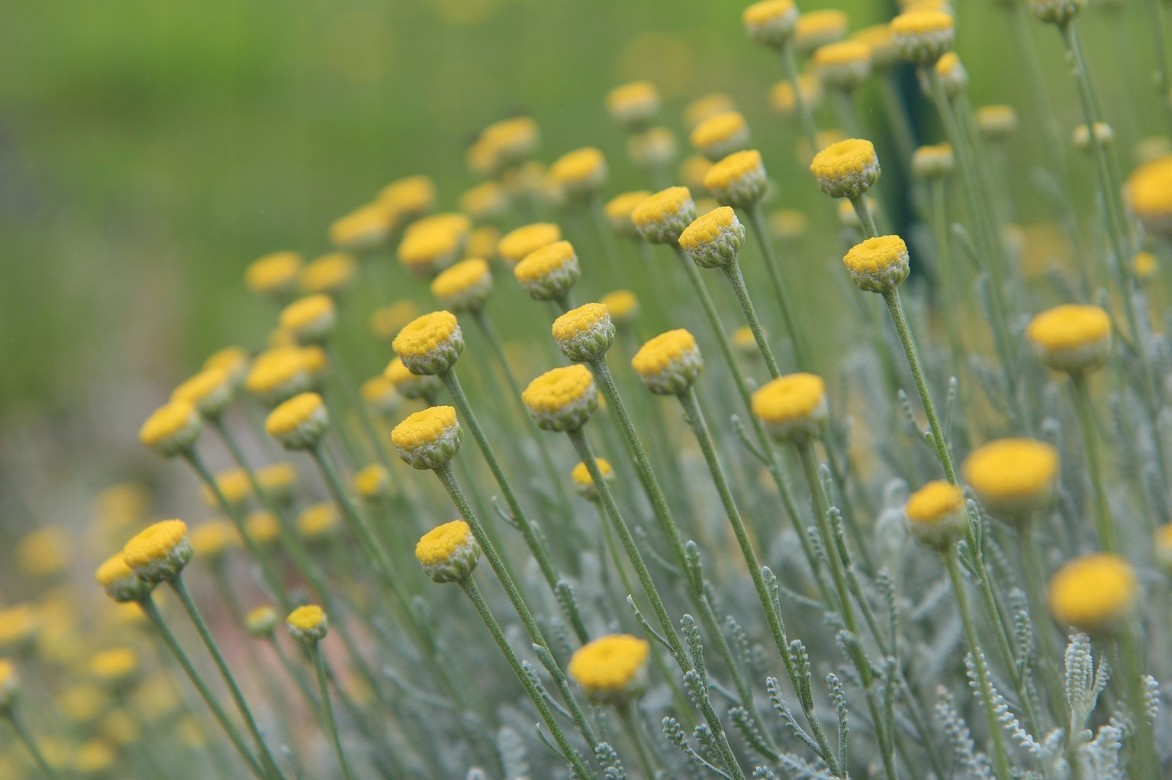
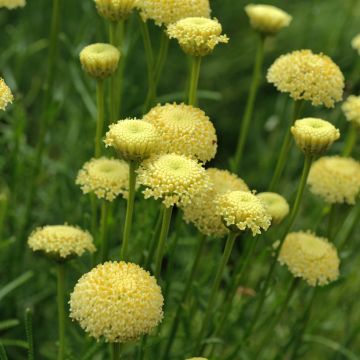

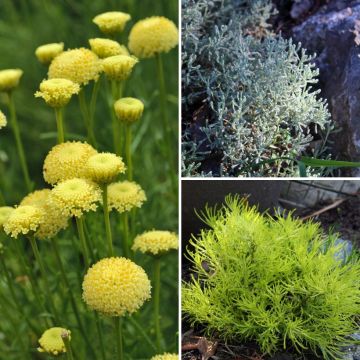



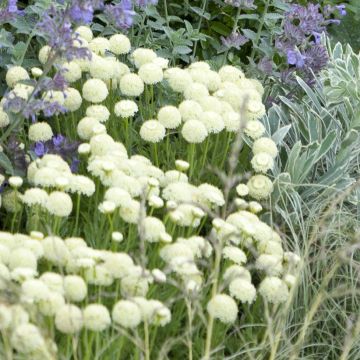
Comments